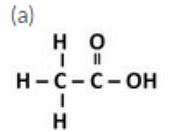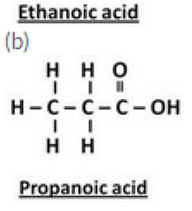Solutions of Carbon And Its Compounds (Page No - 240) - Chemistry Lakhmir Singh, Class 10 | Extra Documents, Videos & Tests for Class 10 PDF Download
Question 10:
Write the name and chemical formula of the simplest organic acid.
Solution :
Formic acid; HCOOH
Question 11:
Write the IUPAC names, common names and formulae of the first two members of the homologous series of carboxylic acids.
Solution :
| IUPAC name | Common name | Formula |
| (i) Methanoic acid | Formic Acid | HCOOH |
| (ii) Ethanoic acid | Acetic acid | CH3COOH |
Question 12:
What is the common name of : (a) methanoic acid, and (b) ethanoic acid ?
Solution :
(a) Methanoicacid – Formic acid
(b) Ethanoic acid – Acetic acid
Question 13:
Draw the structures for the following compounds :
(a) Ethanoic acid (b) Propanoic acid
Solution :


Question 14:
Give the common names and IUPAC names of the following compounds :
(a) HCOOH (b) CH3COOH
Solution :
| Formula | IUPAC name | Common name |
| (i) HCOOH | Methanoic acid | Formic acid |
| (ii) CH3COOH | Ethanoic acid | Acetic acid |
Question 15:
Give the name and structural formula of one homologue of HCOOH.
Solution :
Ethanoic acid; CH3COOH
Question 16:
Write the formulae of: (a) methanoic acid, and (b) ethanoic acid.
Solution :
(a) Methanoic acid: HCOOH
(b) Ethanoic acid: CH3COOH
Question 17:
Give the common name and IUPAC name of C2H5
Solution :
Common name: Ethyl alcohol
IUPAC name: Ethanol
Question 18:
Give the IUPAC name of the following compound :
C3H7OPI
Solution :
Propanol, C3H7OH
Question 19:
Give the name and structural formula of one member of the following :
Alcohols
Solution :
Ethanol; C2H5OH
Question 20:
Give IUPAC names of the following compounds :
(a) C4H9OH (b) C5HnOH
Solution :
(a) Butanol, C4H9OH
(b) Pentanol, C5H11OH
Question 21:
What is the common name of methanol ?
Solution :
Methyl alcohol
Question 22:
What is the difference between two consecutive homologues :
(i) in terms of molecular mass ?
(ii) in terms of number and kind of atoms per molecule ?
Solution :
(i) 14 u
(ii) Two consecutive homologues differ by 1 carbon atom and 2 hydrogen atoms in their molecular formulae.
Question 23:
What type of fuels :
(a) burn with a flame ?
(b) burn without a flame ?
Solution :
(a) Fuels which vaporise on heating, burn with a flame.
(b) Fuels which do not vaporise on heating, burn without a flame.
Question 24:
State whether the following statement is true or false :
The minimum number of carbon atoms in a ketone molecule is two.
Solution :
False
Question 25:
Fill in the following blanks with suitable words :
(a) The next higher homologue of ethanol is……….
(b) The next homologue of C2H5OH is……….
(c) The next higher homologue of ethane is………..
(d) The functional group present in ethanol is……….
Solution :
(a) Propanol
(b) C3H7OH
(c) Propane
(d) -OH (alcohol)
(e) Carboxylic acids
Question 26:
(a) Give the general name of the class of compounds having the general formula CnH2n-2.Write name of the first member of this homologous series.
(b) The general formula of a homologous series of carbon compounds is CnH2n. Write the molecular formulae of the second and fourth members of the series.
(c) Write the molecular formulae of the third and fifth members of homologous series of carbon compounds represented by the general formula CnH2n+2.
Solution :
(a) Alkynes, CnH2n-2
First member: Ethyne
(b) Second member: C3H6
Fourth member: C5H10
(c) Third member: C3H8
Fifth member: C5H12
Question 27:
(a) Give the names and structural formulae of the next two higher homologues of methane.
(b) The molecular formula of a hydrocarbon is C10H18. Name its homologous series.
(c) Select the hydrocarbons which are members of the same homologous series. Give the name of each series.
C5H10 ; C3H8; C6H10; C4H10; C7H12; C8H16
Solution :


Question 28:
(a) Give the molecular formula of one homologue of each of the following :
(i) C3H6 (ii) C2H6 (iii) C2H2
(b) What is the difference in the molecular mass of any two adjacent homologues ?
(c) By how many carbon atoms and hydrogen atoms do any two adjacent homologues differ ?
Solution :
(a) (i) C4H8 (ii) C3H8
(iii) C3H4
(b) 14 u
(c) 1 carbon atom and 2 hydrogen atoms i.e. a CH2 group.
|
5 videos|292 docs|59 tests
|
FAQs on Solutions of Carbon And Its Compounds (Page No - 240) - Chemistry Lakhmir Singh, Class 10 - Extra Documents, Videos & Tests for Class 10
| 1. What are carbon compounds and why are they important? |  |
| 2. What are the different types of carbon compounds? |  |
| 3. How is carbon dioxide formed and what are its effects on the environment? |  |
| 4. What are the sources and consequences of carbon monoxide poisoning? |  |
| 5. How are carbon compounds used in everyday life? |  |
|
5 videos|292 docs|59 tests
|

|
Explore Courses for Class 10 exam
|

|

















